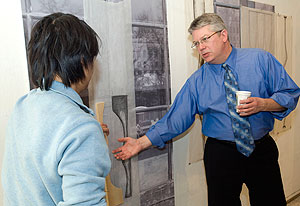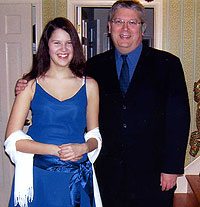St. Louis is a city of confluences: old and new, north and south, the Mississippi and Missouri rivers. Standing atop ancient Cahokia Mounds, one can see Eero Saarinen’s gleaming Gateway Arch, arguably the most recognizable work of modern architecture in the United States.
For Peter MacKeith, that view proved irresistible.

It was 1999, and MacKeith had spent the last decade abroad, living and working in Helsinki, Finland, and writing frequently about contemporary Finnish architecture. But MacKeith was growing restless, and, though he’d never before visited St. Louis, the opportunity to serve as assistant dean and director of graduate admissions for Washington University’s School of Architecture was a potential turning point. A visit to Monk’s Mound, the largest of Cahokia’s earthen structures, settled the matter.
“It struck me that the best place from which to comprehend the United States might be this central location, across which so much flows and which draws together so many things,” MacKeith says. “It seemed to make sense to be here — at this place, on this continent, working within a significant University that was clearly filled with energy and ambition.”
Now things have come full circle for MacKeith, associate dean of the Sam Fox School of Design & Visual Arts and associate professor of architecture. This spring, as St. Louis coordinator for the exhibition “Eero Saarinen: Shaping the Future” — currently on view at the Mildred Lane Kemper Art Museum — MacKeith has focused renewed attention on the Finnish-American architect whose monument to westward expansion has so shaped the region’s identity.
“Peter has spent years working behind the scenes to bring this exhibition to campus,” says Carmon Colangelo, dean of the Sam Fox School of Design & Visual Arts and the E. Desmond Lee Professor for Community Collaboration.
“In many ways, it’s the perfect encapsulation of the school’s mission, combining architecture and design with scholarship and museum studies. And it would not have been possible without him,” Colangelo said.
‘The right message’
MacKeith’s childhood was largely defined by travel. His father taught at private schools in New Jersey, Houston — where MacKeith was born — Seattle and Washington, D.C., before joining the U.S. Food and Drug Administration as a regulator for Asian and Middle Eastern goods. MacKeith says that at the family home in Arlington, Va., “we still keep a very fine world map with pins in the locations where everyone has been.”

Though he drew constantly from an early age, MacKeith’s architectural interests were matched by equally strong fascinations with literature, history and political science. He also was a talented soccer player and was recruited by several colleges before enrolling at the University of Virginia. He served as captain and led the team to its first NCAA tournament, in 1979, while also pursuing degrees in literature and international relations.
Still, in the back of his mind, there remained architecture. And so, as a fourth-year student, MacKeith took his first design studio — taught, ironically, by Robert Vickery, a Washington University alumnus who had helped design Edison Theatre.
“Vickery presented architecture as a field of cultural inquiry,” MacKeith says. “It was politics and history and economics as much as materials and structural techniques.” He was particularly struck by Alvar Aalto’s work, which seemed to combine central architectural issues — ideas about place and light and movement — with a deep material sensitivity.
“It was precisely the right message at precisely the right time,” MacKeith says.
Material sensibilities
MacKeith spent the next year working in Vickery’s office (and serving as assistant soccer coach) and then entered the Yale School of Architecture.
After earning a master’s degree in 1985, he remained at Yale as a design critic and residential college dean and to complete the editing (with David Thompson) of Perspecta 24: The Yale Architectural Journal. Published by Rizzoli International in 1988, the volume featured a who’s who of contemporary architects and theorists — including Fumihiko Maki, Roland Barthes and Mario Botta — and sought to navigate between the postmodern and structuralist camps.
“Architecture is not just a shallow representation of eclectically chosen histories, nor is it simply an attempt to ‘build theory,’ ” MacKeith says.
Rather, architecture, MacKeith says, “has its own substance and should invest itself in material sensibilities” —an approach perhaps best exemplified by the refined pragmatism of Aalto and other Finnish architects.
In 1989, MacKeith won a Fulbright Fellowship to study Aalto’s church designs and arrived in Helsinki with the start of the new year. There, he began lecturing at the Helsinki University of Technology (TKK is the Finnish acronym) and later took a job with his Fulbright adviser, the influential architect Juhani Pallasmaa, with whom he would design the House Siltavuori and the 1991 Venice Biennale exhibition for Finland.
Still, “why you go to a place is one thing,” MacKeith muses. “Why you choose to stay depends upon something deeper.”
For MacKeith, that something was the birth of his daughter, Ada, in 1993. Yet, the Finnish economy was faltering, and, though Ada’s mother was a citizen, MacKeith was “a foreigner with a labor permit,” as he dryly remembers.
To make ends meet, he commuted between teaching appointments at TKK and the University of Virginia. He also began writing articles and reviews for what would become a long list of periodicals, from Architecture and Architectural Record to Korean Architects’ Review, Italy’s Casa Bella and Australia’s Monument.
The international teeter-totter came to rest in 1994, when Pallasmaa — now dean of architecture at TKK — tapped MacKeith to run its new International Masters Program.
He also continued writing criticism, traveling to Oslo, Copenhagen, Stockholm and other Nordic and Scandinavian environs.
In 1996, while giving tours during an Aalto symposium, he was recruited by Peter Reed, a curator for the Museum of Modern Art (MOMA) in New York, to produce analytical drawings for MOMA’s 1998 Aalto retrospective.
|
Peter MacKeith |
|
Education: B.A., literature and international relations, 1981, University of Virginia; M.Arch., 1985, Yale School of Architecture Family: daughter, Ada, 16 Selected publications: Perspecta 24: The Yale Architectural Journal (1988); “The Finland Pavilions: Finland at the Universal Expositions 1900-1992” (1992); “The Dissolving Corporation: Contemporary Architecture and Corporate Identity in Finland” (2005); “Encounters: Architectural Essays” (2005); and “Archipelago: Essays on Architecture” (2006) Selected grants and awards: Fulbright Fellowship, 1990; Finnish Cultural Foundation, 1992; Graham Foundation for Advanced Studies in the Fine Arts, 2001, 2008; Finnish Center for Business and Policy Studies (EVA), 2003-04; Creative Achievement Award, Association of Collegiate Schools of Architecture, 2008; I-CARES, Washington University, 2008 |
Accelerating shifts
MacKeith arrived at Washington University just as architecture was beginning the process — with the School of Art and the Kemper Art Museum — of forming the larger Sam Fox School.
This involved the reorganization of programs, personnel and facilities as well as the construction of two new buildings, which opened in 2006. (Ironically, their architect was Maki, who had contributed to MacKeith’s Perspecta 24.)
“The last nine years can only be characterized as a constant state of transition,” says MacKeith, who became associate dean of the Sam Fox School in 2004. “My charge, as I understood it, was to assist in accelerating those shifts, and to intensify and expand the graduate program as well as the reputation of the school through publications and communications with the architectural profession.”
Thanks in large part to those efforts, the Graduate School of Architecture & Urban Design has doubled in size, from 110 students in 1999 to 220 in 2008, while its national reputation has steadily risen.
Last fall, it was ranked sixth by DesignIntelligence, which polls hundreds of architectural executives.
MacKeith also currently oversees the Whitaker Foundation Learning Lab, a new media center, and helped launch studios in Copenhagen and Helsinki, where he maintains strong ties, returning every five or six weeks.
In 2005, MacKeith published “The Dissolving Corporation: Contemporary Architecture and Corporate Identity in Finland” and also reunited with Pallasmaa to edit the collection “Encounters: Architectural Essays,” short-listed for the 2006 Royal Institute of British Architects’ International Book Award.
Last spring, he won a national Creative Achievement Award from the Association of Collegiate Schools of Architecture for his interdisciplinary studio “Lighthouses: Adventures on the Mississippi.”
MacKeith’s involvement with “Eero Saarinen: Shaping the Future” dates back to 2004, when he brought Jukka Valtasaari, Finnish ambassador to the United States and honorary chair of the organizing committee, to tour the Kemper Art Museum, then still under construction.
“We had to demonstrate that we had a museum building of real quality,” he says, “one that would suit the exhibition’s specifications.”
The lobbying proved successful, and MacKeith began recruiting a host of local co-sponsors. With Eric Mumford, associate professor of architecture, he also curated an attendant exhibition, “On the Riverfront: St. Louis and the Gateway Arch,” and organized an international symposium of the same title.
“We wanted to highlight the civic nature of the Arch as well as the broad regional vision that brought it into being,” MacKeith says. At the same time, the confluence of Finnish and American architectural cultures, as embodied by the Arch, “does represent something of a coming home.”
“This is quite potent personally,” he says. “But I think it also reinforces our sense of community — between the city and the University as well as between these two nations.”